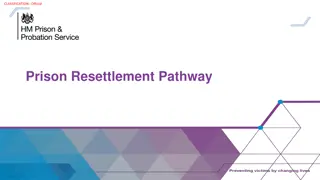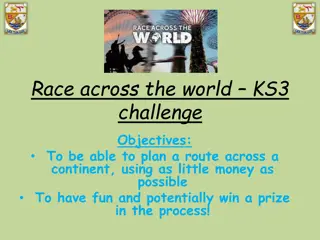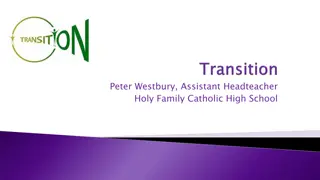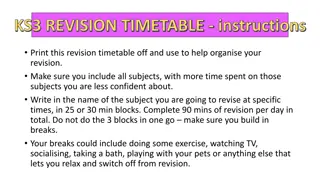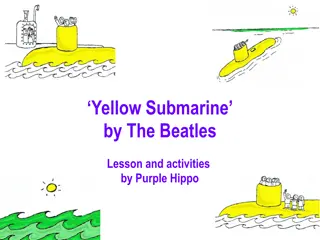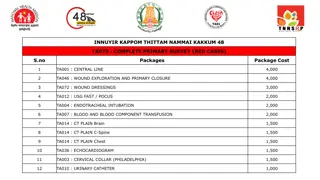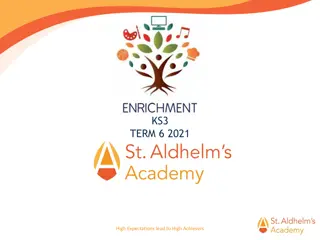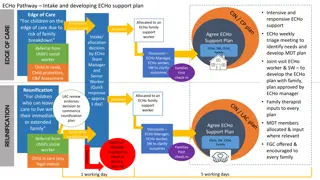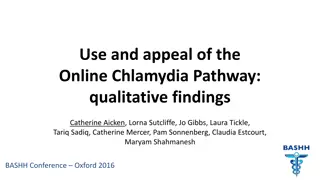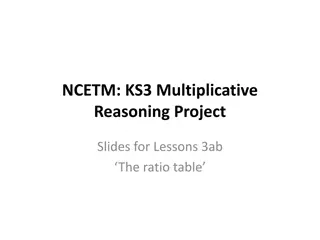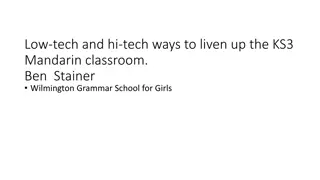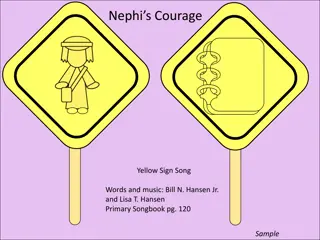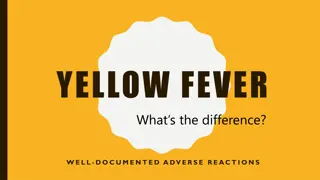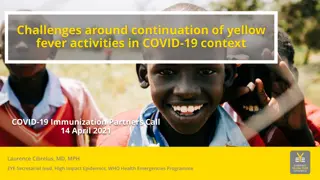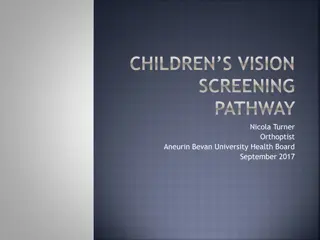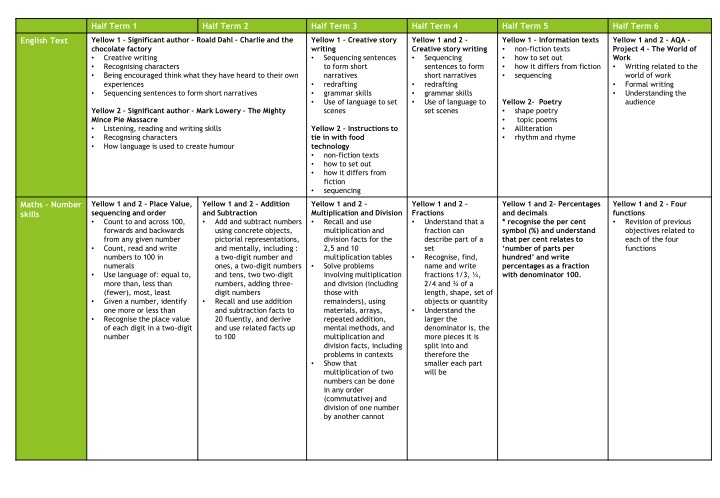
Exploring Curriculum Topics in English and Mathematics
Delve into a diverse range of educational topics in English and Mathematics, covering creative writing, literature analysis, number skills, and more. Discover engaging activities related to significant authors, story sequencing, place value, addition, subtraction, multiplication, fractions, percentages, and decimals. Enhance language skills through poetry and non-fiction writing while honing mathematical concepts through practical applications and problem-solving tasks.
Download Presentation

Please find below an Image/Link to download the presentation.
The content on the website is provided AS IS for your information and personal use only. It may not be sold, licensed, or shared on other websites without obtaining consent from the author. If you encounter any issues during the download, it is possible that the publisher has removed the file from their server.
You are allowed to download the files provided on this website for personal or commercial use, subject to the condition that they are used lawfully. All files are the property of their respective owners.
The content on the website is provided AS IS for your information and personal use only. It may not be sold, licensed, or shared on other websites without obtaining consent from the author.
E N D
Presentation Transcript
Half Term 1 Half Term 2 Half Term 3 Half Term 4 Half Term 5 Half Term 6 Yellow 1 Significant author Roald Dahl Charlie and the chocolate factory Creative writing Recognising characters Being encouraged think what they have heard to their own experiences Sequencing sentences to form short narratives Yellow 1 Creative story writing Sequencing sentences to form short narratives redrafting grammar skills Use of language to set scenes Yellow 1 and 2 Creative story writing Sequencing sentences to form short narratives redrafting grammar skills Use of language to set scenes Yellow 1 Information texts non-fiction texts how to set out how it differs from fiction sequencing Yellow 1 and 2 - AQA Project 4 The World of Work Writing related to the world of work Formal writing Understanding the audience English Text Yellow 2- Poetry shape poetry topic poems Alliteration rhythm and rhyme Yellow 2 Significant author Mark Lowery The Mighty Mince Pie Massacre Listening, reading and writing skills Recognsing characters How language is used to create humour Yellow 2 Instructions to tie in with food technology non-fiction texts how to set out how it differs from fiction sequencing Yellow 1 and 2 Place Value, sequencing and order Count to and across 100, forwards and backwards from any given number Count, read and write numbers to 100 in numerals Use language of: equal to, more than, less than (fewer), most, least Given a number, identify one more or less than Recognise the place value of each digit in a two-digit number Yellow 1 and 2 Addition and Subtraction Add and subtract numbers using concrete objects, pictorial representations, and mentally, including : a two-digit number and ones, a two-digit numbers and tens, two two-digit numbers, adding three- digit numbers Recall and use addition and subtraction facts to 20 fluently, and derive and use related facts up to 100 Yellow 1 and 2 Multiplication and Division Recall and use multiplication and division facts for the 2,5 and 10 multiplication tables Solve problems involving multiplication and division (including those with remainders), using materials, arrays, repeated addition, mental methods, and multiplication and division facts, including problems in contexts Show that multiplication of two numbers can be done in any order (commutative) and division of one number by another cannot Yellow 1 and 2 Fractions Understand that a fraction can describe part of a set Recognise, find, name and write fractions 1/3, , 2/4 and of a length, shape, set of objects or quantity Understand the larger the denominator is, the more pieces it is split into and therefore the smaller each part will be Yellow 1 and 2 Percentages and decimals * recognise the per cent symbol (%) and understand that per cent relates to number of parts per hundred and write percentages as a fraction with denominator 100. Yellow 1 and 2 Four functions Revision of previous objectives related to each of the four functions Maths Number skills
Yellow 1 2D and 3D shape Identify and describe the properties of 2D and 3D shapes, including the numbers of sides and line of symmetry in a vertical line Identify 2D shapes on the surface of 3D shapes Compare and sort common 2D and 3D shapes and everyday objects Yellow 1 Mass and Capacity Choose and use appropriate standard units to estimate and measure Compares and orders lengths, mass, volume/capacity and records the results using <,> and = Yellow 1 Time Compare and sequence intervals of time Tell and write time to five minutes, including quarter past/to the hour and draw hands on clock Yellow 1 Money Recognise and use symbols for pounds and pence; combine amounts to make a particular value, find different combinations of coins that equal the same amount of money, give change Yellow 1 and 2 Length and height Choose and use appropriate standard units to estimate and measure Compares and orders lengths and records the results using <,> and = Yellow 1 Interpreting data Interpret and construct simple pictograms, tally charts, block diagrams and simple tables Sort objects, numbers and shapes to a given criterion and their own Maths - topic Yellow 2 - 2D and 3D shape Identify and describe the properties of 2D and 3D shapes, including the numbers of sides and line of symmetry in a vertical line Identify 2D shapes on the surface of 3D shapes Compare and sort common 2D and 3D shapes and everyday objects Yellow 2 Money Recognise and use symbols for pounds and pence; combine amounts to make a particular value, find different combinations of coins that equal the same amount of money, give change Yellow 2 Time Compare and sequence intervals of time Tell and write time to five minutes, including quarter past/to the hour and draw hands on clock Yellow 2 - Interpreting data Interpret and construct simple pictograms, tally charts, block diagrams and simple tables Sort objects, numbers and shapes to a given criterion and their own Yellow 2 - Perimeter and Area Measure and calculate the perimeter of a rectilinear figure (including squares) in cm and m Knows area is a measure of surface within a given boundary Finds the area of rectilinear shapes by counting squares Yellow 1 and 2 - Elements, mixtures and compounds Compare and group materials together, according to whether they are solids, liquids or gases Observe that some materials change state when they are heated or cooled. To know how elements can join together to form compounds with new properties. To know that mixtures are made up of a combination of elements. Yellow 1 and 2 - Plants and Photosynthesis Identify and describe the functions of different parts of flowering plants : roots, stem/trunk, leaves and flowers Explore the requirements of plants for life and growth and how they vary from plant to plant Investigate the way in which water is transported within plants Explore the part that flowers play in the life cycle of flowering plants, including pollination, seed formation and seed dispersal Yellow 1 and 2 - Microbes and Disease To know what the different types of microbes are (bacteria, fungi & viruses) To know how microbes can cause disease To develop an understanding of ways in which we can prevent the spread of microbes Yellow 1 and 2 Energy To know the different types of energy (light, sound, heat, electrical) To understand how important energy is in our everyday lives To know that energy transfers take place and develop an understanding of this Science Yellow 1 and 2 Hinduism Respecting all religions and others beliefs Important customs and festivals Special books and buildings Related symbols Yellow 1 and 2 - Christian festivals including Christmas Respecting all religions and others beliefs Important customs and festivals Special books and buildings Related symbols Yellow 1 and 2 - Being a Muslim Respecting all religions and others beliefs Important customs and festivals Special books and buildings Related symbols Yellow 1 and 2 - Bible stories * How stories teach us about the Christian religion Yellow 1 and 2 - Places of worship How to behave in religious buildings What symbols and objects are found in places of worship Understand which religions use which buildings Yellow 1 and 2 Sikhism Respecting all religions and others beliefs Important customs and festivals Special books and buildings Related symbols RE
Word, Font, cutting pasting, saving and retrieving E-safety Emailing Starz Use technology safely, respectfully and responsibly Recognise acceptable/unacceptable behaviour Identify a range of ways to report concerns about content and conatct Animation Undertake creative projects that involve selecting, using and combining multiple applications, preferably across a range of devices, to achieve challenging goals Editing Power point presentations Opening Saving Retrieving Editing Yellow 1 Coding Use the repeat command within a series of instructions Use conditional statements Use a variety of inputs Computing Opening Saving Retrieving editing Yellow 2 Power point presentations Opening Saving Retrieving Editing Textiles - Sewing Cross stitching and gifts Use research and develop design criteria to inform the design of innovative and appealing products Use a wider range of tools and equipment to perform practical tasks Evaluate their ideas Yellow 1 Resistant materials Making a board game (can relate to history topic of Victorians) Use research and develop design criteria to inform the design of innovative and appealing products Use a wider range of tools and equipment to perform practical tasks Evaluate their ideas Yellow 1 - Food technology healthy meals and meal planning Reading recipes Food shopping Working hygienically (can relate to historic recipes of 50s and 60s) Creativity/ DT Yellow 2 Resistant materials related to Anglo-Saxons Use research and develop design criteria to inform the design of innovative and appealing products Use a wider range of tools and equipment to perform practical tasks Evaluate their ideas Yellow 2 Food technology healthy meals and meal planning Reading recipes Food shopping Working hygienically Yellow 1 1900s artists to relate to history topic of WW1 Be taught about great artists in history Yellow 1 Brazilian art to tie in with geography topic To improve their mastery of art and design techniques Collage Tone and texture Indian artwork related to geography topic Collage Painting To improve their mastery of art and design techniques Yellow 1 Local artists Be taught about great artists in history Yellow 1 Related to history topic of 50s and 60s Be taught about great artists in history Collage Painting To improve their mastery of art and design techniques Art Yellow 2 Indian art To improve their mastery of art and design techniques Collage Tone and texture Yellow 2 Related to history topic of famous leaders To improve their mastery of art and design techniques Yellow 2 Related to history topic of Anglo-Saxons and geography topic of Savannah Grasslands Collage Painting To improve their mastery of art and design techniques Yellow 2 Related to history topic of monarchs Collage Painting To improve their mastery of art and design techniques
Yellow 1 World War I A study of an aspect or theme in British history Know and understand the history of these islands as a coherent, chronological narrative Understand historical concepts such as continuity and change, cause and consequence Understand methods of historical enquiry Yellow 1 World War I A study of an aspect or theme in British history Know and understand the history of these islands as a coherent, chronological narrative Understand historical concepts such as continuity and change, cause and consequence Understand methods of historical enquiry Yellow 1 Victorians A study of an aspect or theme in British history Know and understand the history of these islands as a coherent, chronological narrative Understand historical concepts such as continuity and change, cause and consequence Understand methods of historical enquiry Yellow 1 50s and 60s A study of an aspect or theme in British history Know and understand the history of these islands as a coherent, chronological narrative Understand historical concepts such as continuity and change, cause and consequence Understand methods of historical enquiry History Yellow 2 Monarchs, The Great Plague and The Great Fire of London A study of an aspect or theme in British history The changing power of monarchs Know and understand the history of these islands as a coherent, chronological narrative Understand historical concepts such as continuity and change, cause and consequence Understand methods of historical enquiry Yellow 2- Anglo-Saxons A study of an aspect or theme in British history Britain s settlement by Anglo-Saxons Know and understand the history of these islands as a coherent, chronological narrative Understand nature of ancient civilisations Understand historical concepts such as continuity and change, cause and consequence Understand methods of historical enquiry Yellow 2 Famous leaders A study of an aspect or theme in British history Know and understand the history of these islands as a coherent, chronological narrative Understand historical concepts such as continuity and change, cause and consequence Understand methods of historical enquiry Yellow 2 Monarchs A study of an aspect or theme in British history The changing power of monarchs Know and understand the history of these islands as a coherent, chronological narrative Understand historical concepts such as continuity and change, cause and consequence Understand methods of historical enquiry Yellow 1 and 2 Weather Understand the processes that give rise to key physical and human geographical features of the world Identify seasonal and daily weather patterns Yellow 1 and 2 Brazil Develop contextual knowledge of the location of globally significant places Interpret a range of sources of geographical information Understand geographical similarities and differences Yellow 1 and 2 India Develop contextual knowledge of the location of globally significant places Interpret a range of sources of geographical information Understand geographical similarities and differences Yellow 1 and 2 - Savannah Grasslands Develop contextual knowledge of the location of globally significant places Interpret a range of sources of geographical information Understand geographical similarities and differences Geography
Zones of Regulation Self-awareness Things I am good at Kind and unkind behaviours Playing and working together People who are special to us Getting on with each other Zones of Regulation Self-care Support and safety Taking care of ourselves Keeping safe Trust Keeping safe online Public and private Zones of Regulation The world I live in Respecting differences between people Jobs people do Rules and laws Taking care of our environment Belonging to a community Money Zones of Regulation The world I live in Respecting differences between people Jobs people do Rules and laws Taking care of our environment Belonging to a community Money Managing feelings Identifying and expressing feelings Managing strong feelings Zones of Regulation Healthy lifestyles Healthy eating Taking care of physical health Keeping well Zones of Regulation Changing and growing Baby to adult Changes at puberty Dealing with touch Different types of relationships PSHE PE Football Gym Swimming Develop competence to excel in a broad range of physical activities To be physically active for sustained periods of time Engage in competitive sports and activities Apply basic principles for attacking and defending Take part in outdoor and adventurous activity challenges both individually and within a team Compare their performances with previous ones and demonstrate improvement to achieve their personal best Swim competently, confidently and proficiently Use a range of strokes effectively Duchess of Ely Exploring our environment Safety Team work activities Understanding our environment including weather observations and identifying local human and physical features Looking after our environment How to look after our environment How and what to recycle/reuse and the effects of pollution both locally and in the wider world Habitats Research different animals habitats both local and wider environment Make bug hotel or hedgehog house Investigate habitats in local community Wildlife Researching animal facts Look at local food chains Make animal feeders Create a nature hunt for younger pupils to complete Food and Shelter Identifying foods that grow locally Tasting food cooked on a campfire/camping stove Preparing and cooking small camp meals Yellow 1 - Navigation and Travel Identify different directional language Follow a route plan or map Create map or plan Plan a journey to a local place Yellow 2 - Food and Shelter Identifying foods that grow locally Tasting food cooked on a campfire/camping stove Preparing and cooking small camp meals


